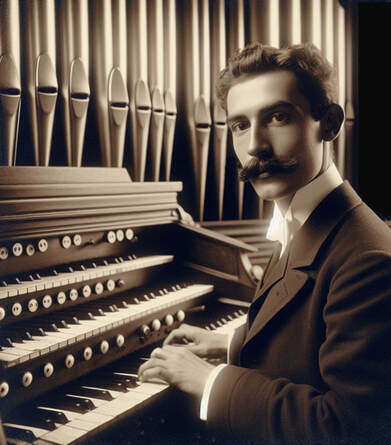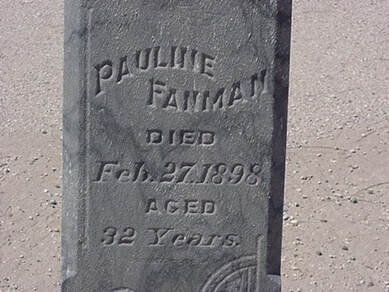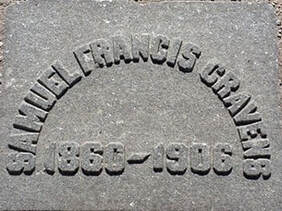 Louis A. Geary, 1869-1906 Music Teacher and Orchestra Leader Buried in Rosedale Cemetery (exact location unknown) (Generic image of an orchestra created using Bing AI) According to his 1906 newspaper obituary, Louis A. Geary had been a music teacher and the leader of an orchestra in California before he fell ill with consumption and moved to Phoenix, Arizona, for his health.
Geary was born in 1869, probably in Binghamton, Broome County, New York, to Patrick Geary and Mary Garvey. Patrick was an Irish immigrant and a shoemaker by trade. The Gearys had five children. Although Mr. Geary probably made a respectable living, it is still surprising that three of the Geary children were able to study music. In 1892, Mary E. “Mamie” Geary, the eldest daughter, was listed simply as a music teacher but, by 1895, she was a violin instructor at Ward’s Seminary for Young Ladies in Nashville, Tennessee. She is said to have studied with Madame Dove Boetti, Professor Giuseppe Vecchione, and Madame Carmilla Urso (a violin virtuoso)—all important names in their day. By 1915, Mamie was the head of the New City School of Music in Chicago, and her sister Margaret was a piano instructor in Chicago. Their brother Louis seems to have come to his musical career by a more circuitous route. In 1892, he appeared on the New York State census as a cigar maker. Not until later did he move to California where he taught music and performed with an orchestra. By 1906, Louis Geary was suffering from consumption, and he and his wife came to Phoenix where they took up lodgings on North First Street. Nevertheless, Geary’s health declined rapidly. When he died on May 29th, his widow was practically penniless and sought financial help from the in-laws she had heard about but never met. Geary’s funeral was delayed while Phoenix Marshal Kinney telegraphed his father, who was by then living in Chicago, Illinois. When Geary’s father responded a week after his death, Kinney learned that his family back East had not heard from him in two years and were not even aware that he had married. Perhaps a family rift had caused the Gearys to stop communicating. Louis Geary was buried in Rosedale Cemetery. Since no headstone has been found, the exact location is no longer known. The fate of his widow is also unknown, although she probably returned to California. © 2024 by Donna L. Carr. Last revised 25 April 2024. If you would like assistance researching our interred, you can find more information on our website. You can contact us at [email protected] at any time. Thank you for your interest to preserve the history of Arizona's pioneers!
0 Comments
 Professor H. Cresswell Shaw 1855 -1902 Organist Buried in Rosedale Cemetery, Block S147, Grave 2 (Generic image created using Bing AI) Henry Cresswell Shaw was born November 1855 in Canada, possibly in Guelph, a city in Ontario about 43 miles from Toronto. Guelph had a strong music and arts tradition. It was also home to the Bell Organ Company. Founded in 1864, it manufactured reed and pump organs, pianos and melodeons, as well as a small number of pipe organs. Perhaps it was not surprising, then that Shaw studied music and became an organist.
In 1881, Shaw seems to have been a music dealer in Guelph when he transcribed for publication a piano arrangement of the song, The Palms (Les Rameaux par Faure). It was dedicated to a Miss Bertie Geddes, a church organist in Hamilton and Guelph, Ontario. A copy exists in the University of Michigan Library. In 1883, Shaw became the organist for St. Peter’s Church in Berlin, Ontario, a position he would hold for the next sixteen years. (Berlin no longer appears on the map as a Canadian city. Its name was changed to Kitchener in 1916 when Canada entered World War I as part of the British Empire. Shaw proved to be a devoted church worker and was especially popular with the young people’s groups. Shaw’s hobby was horticulture. In June 1895, he built Rosehurst Conservatories. With the help of a gardener, the Conservatories grew roses, lilies, and a variety of other hothouse flowers during Canada’s winters. By 1896, Shaw was suffering from Bright’s Disease and sought a warmer climate during the winter. He moved to Phoenix permanently in 1899, having secured a position as organist at the First Methodist Episcopal Church which had recently had its pipe organ refurbished. In the summer of 1901, he made a brief trip—possibly his last—back home to Canada. Shaw died on March 31, 1902, in his rooms at 524 South First Avenue11. The Rev. E. A. Penick conducted his funeral, after which Shaw was buried in Rosedale, Section 147, Grave 2. © 2024 by Donna L. Carr. Last revised 12 April 2024. If you would like assistance researching our interred, you can find more information on our website. You can contact us at [email protected] at any time. Thank you for your interest to preserve the history of Arizona's pioneers!  Mary E. “Pauline” Fielder Fayman 1867-1898 Pianist and Singer Buried in Loosley Cemetery, Block 11, Lot 21, Grave 3 (Image courtesy of the Pioneers’ Cemetery Association) Mary E. Fielder was born about 1867 in Georgia. She was the youngest child of Herbert Fielder and Mary Blance. Her father, a lawyer, was a prolific writer involved in southern politics.
Since Mary’s sister Kallura was sent to Ward’s Seminary for Young Ladies (a finishing school) in Tennessee, it seems likely that Mary too attended Ward’s where she became a concert-level pianist and vocalist. Around 1884, the Fielders relocated to Deming, New Mexico, where Mr. Fielder opened a new law office. Here, Mary met and married James William Fayman, a clerk for the Southern Pacific Railroad. The young couple moved to Los Angeles, California in 1887, where they became involved with the social life of the Los Angeles area and were often mentioned in the newspapers. Mary taught music and performed with her students as well as solo. Sometime around 1894, the Faymans moved to Truckee, California. There, Mary became involved in a romantic relationship with a well-known male resident of that city. Their marriage at an end, James returned to Los Angeles and Mary went to live with her brother in Silver City, New Mexico. Mary’s movements during the next few years are difficult to trace, but somewhere along the way she developed a fondness for absinthe, a liquor often associated with artists and a bohemian lifestyle. She is said to have gone to Tucson, Arizona, to sing in saloons and then returned to Los Angeles, where she rented lodgings under the name of Josie Black. She arrived in Phoenix, Arizona, at the end of 1897 where she found employment playing piano and singing at the Anheuser Saloon under the name of Pauline Fayman. Mary had been drinking heavily on the evening of February 27, 1898. Around 1 AM, she returned to her room at the St. Lawrence Hotel where she took a large dose of a white powder. A doctor was summoned but she refused medical help when he arrived, claiming it was only baking soda. She was discovered dead the following afternoon, and a coroner’s inquest determined that she had in fact ingested morphine. The investigation into her death also turned up a photograph that had been torn into pieces. Written on the back of one scrap was “Don’t bury me in a pauper’s grave. Don’t telegraph my brother at Silver City.” Mary’s friends and brother carried out her last wish. She was buried in Loosley Cemetery in Phoenix, Arizona, under the name of Pauline Fayman, although her surname on the grave marker is spelled incorrectly as Fanman. © 2018 by Patty Gault, PCA. Last revised March 2018. If you would like assistance researching our interred, you can find more information on our website. You can contact us at [email protected] at any time. Thank you for your interest to preserve the history of Arizona's pioneers!  Samuel Francis Cravens 1860-1906 Choral Director and Music Instructor Buried in Porter Cemetery, Block 47, Grave C (Grave marker photo courtesy of the Pioneers’ Cemetery Association, Inc.) Professor S. F. Cravens, a highly-regarded choral director and music instructor, founded the Cravens School of Music with his wife in 1903. Although it lasted less than five years, it was the first of its kind in the Arizona Territory.
Cravens, born 1860 in Missouri, was the son of Joshua Cravens and Mary Catherine Hulett. By 1884, he was a music professor in Albany, Missouri. Samuel very likely met his future bride, Etta Dent, through their shared interest in music. The daughter of William and Lucinda Dent, she was something of a music prodigy. Samuel and Etta were married on April 19, 1887, in Manhattan, Kansas. The young couple opened the first Cravens School of Music in Topeka, Kansas. In 1892, they spent a season in Europe, studying under Oscar Beringer in London. Upon their return to the States, they became directors of music at the University of Denver. Around 1895, Samuel was diagnosed with tuberculosis, and the Cravens decided to move to Ottawa, Kansas, where the winter weather was not as severe. November 1895, Samuel was a professor of vocal music at Ottawa University, a co-ed Christian university in Ottawa, Kansas. Etta Dent Cravens, an accomplished pianist, also taught there. Samuel’s fragile health led the Cravens to alternate between their home in Ottawa during the summer and Phoenix, Arizona, in the winter. They opened a new music school in Phoenix so they would have an income with which to support themselves while there. In spite of his chronic health problems, Samuel Craven still enjoyed some musical triumphs during the summers. The most important one was the Kansas Music Festival in Ottawa, a multi-day event for which Craven organized and directed twelve different choral groups totaling a thousand singers. Samuel died on October 31, 1906, and was buried in Porter Cemetery. After his death, Etta returned to Kansas and reopened the Cravens School of Music in Emporia. Its recitals and concerts were widely attended by the public. She died of breast cancer on April 26, 1921, in Emporia, Kansas. ©2024 by Donna L. Carr. Last revised 31 March 2024. If you would like assistance researching our interred, you can find more information on our website. You can contact us at [email protected] at any time. Thank you for your interest to preserve the history of Arizona's pioneers! |